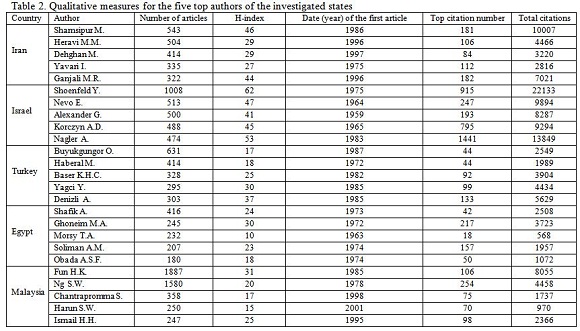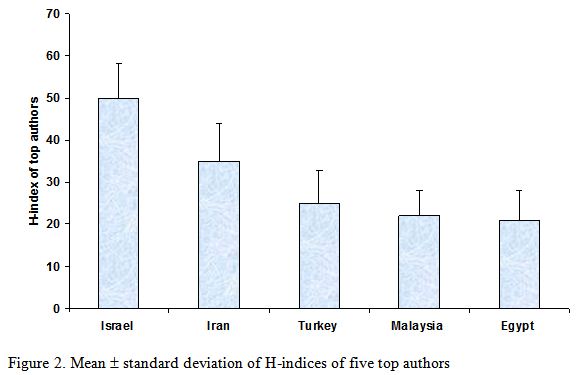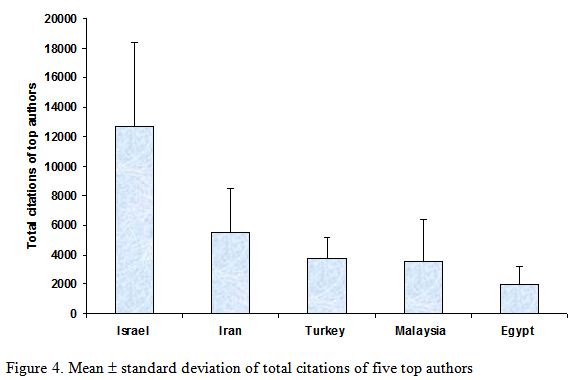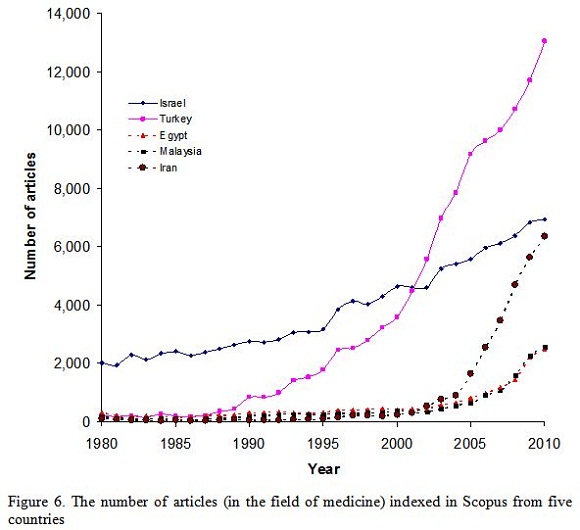Services on Demand
Journal
Article
Indicators
-
 Cited by SciELO
Cited by SciELO -
 Access statistics
Access statistics
Related links
-
 Cited by Google
Cited by Google -
 Similars in
SciELO
Similars in
SciELO -
 Similars in Google
Similars in Google
Share
Revista Colombiana de Ciencias Químico - Farmacéuticas
Print version ISSN 0034-7418On-line version ISSN 1909-6356
Rev. colomb. cienc. quim. farm. vol.40 no.2 Bogotá July/Dec. 2011
Artículo de reflexión
Contribution of Iranian chemists in research activities, on the occasion of the International Year of Chemistry
Contribuciones investigativas de los químicos iraníes, en ocasión del Año Internacional de la Química
Maryam Khoubnasabjafari1, Eliza Sadeghifar2, Majid Khalili3, Jalil Vaez-Gharamaleki4, Abolghasem Jouyban5
1 Tuberculosis and Lung Disease Research Center, Tabriz University of Medical Sciences, Tabriz, Iran.
2 Liver and Gastrointestinal Diseases Research Center, Tabriz University of Medical Sciences, Tabriz 51664, Iran.
3 Medical Philosophy and History Research Center, Tabriz University of Medical Sciences, Tabriz 51664, Iran.
4 Hematology-Oncology Research Center, Tabriz University of Medical Sciences, Tabriz 51664, Iran.
5 Drug Applied Research Center and Faculty of Pharmacy, Tabriz University of Medical Sciences, Tabriz 51664, Iran.
Received for evaluation: August 22, 2011
Accepted for publication: October 25, 2011
SUMMARY
On the occasion of the International Year of Chemistry (2011), scientometric analysis of the publications of Iran, Turkey, Egypt, Israel and Malaysia in all fields and also in four chemistry sub-categories were extracted from Scopus and a number of quantitative and qualitative measures of the publications were discussed. Based on these findings, Iran is the leading state among the investigated countries in the field of chemistry concerning the number of publications and Israel is the leading state followed by Iran when the qualitative measures are considered.
Key words: Scientometric, Iranian chemists, International Year of Chemistry.
RESUMEN
Con ocasión del Año Internacional de la Química (2011) en este trabajo se realizó un análisis cienciométrico de los artículos publicados por científicos de Irán, Turquía, Egipto, Israel y Malasia en todos los campos investigativos y también en cuatro subcategorías de la química, según lo reportado en el sistema Scopus, a partir de lo cual, se discutieron varios aspectos cualitativos y cuantitativos sobre la producción académica. De acuerdo a lo obtenido, a nivel químico Irán es el líder entre los países evaluados en lo relacionado con el número de artículos publicados, mientras que Israel es el líder, seguido por Irán, al considerar los respectivos aspectos cualitativos de los autores y las publicaciones.
Palabras clave: Cienciometría, Químicos iraníes, Año Internacional de la Química.
INTRODUCTION
Academy of Gundishapur in Ahvaz was the oldest university in Iran belongs to Sassanids era (226-652 AD) which was mainly active in medical sciences (1). The Rab'-e Rashidi complex in Tabriz founded by Rashid al-Din Hamedani (13th century) was the most active university in the area in which national and international students were graduated in various disciplines. This complex was equipped with a big paper factory, a massive library, an educational treatment center (Dar-ol-Shafa), Quranic Center (Dar-ol Quran), residential facilities for teachers, student's quarter, a big caravansary and other facilities. Mirza Taghi Khan Amir Kabir founded Dar ul-Funun polytechnique in Tehran in 1851. A branch of Dar ul-Funun was established in Tabriz some years later. Seven Austrians were the first lecturers of Dar ul-Funun (2). Some other modern higher education schools were established in Tehran. In 1934, University of Tehran was established and became the main university of Iran and after that, universities through Iran were established in major cities including Tabriz, Ahvaz, Isfahan, Shiraz and Mashhad. University of Tabriz was established in 1945 as the second modern university of Iran.
Examples of Iranian chemists in the history of chemistry include Geber, Rhazes, Avicenna and others as the famous scholars in the field. Jaber Ibn Hayyan or Geber, the famous Iranian chemist who died in 721 at Tous (near to Mashhad), was the father of a number of discoveries recorded in an encyclopaedia and of many treatises covering two thousand topics, and these became the bible of European chemists of the 18th century, particularly of Lavoisier. Geber is widely regarded as the founder of chemistry, inventing many of the basic processes and equipment still used by chemists today. Mohammad-e Zakariã-ye Razi or Rhazes (865-925) was born in the city of Rey (near to Tehran) and was one of the most famous scholars of Iran. He was an active scientist in various disciplines including medicine, pharmacy and chemistry. Razi developed several chemical instruments and is known to have perfected methods of distillation and extraction, which have led to his discovery of sulfuric acid and alcohol (ethanol). These discoveries paved the way for other Persian alchemists to discover various other mineral acids. Razi was the first to distill/refine petroleum and produce kerosene. "Secrets of secrets" (Serr al-asrar) is the Razi's most famous book which has gained a lot of recognition in the West. In this book he gave systematic attention to the basic chemical operations. He also authored 20 other books in the field of alchemy (the science of converting basic metals to gold or silver). Ibn Sina or Avicenna was born (in 980) in Bukhara and died (in 1037) in Hamadan. Avicenna had significant contribution in the field of medicine and his great work is "The Canon of Medicine". In chemistry, the chemical process of steam distillation was described and used to produce alcohol and essential oils. He also invented the refrigerated coil, which condenses the aromatic vapours which was a breakthrough in distillation technology. As a chemist, Avicenna was one of the pioneers of refutation on alchemy. Four of his works on the refutation of alchemy were translated into Latin. Among them "Liber Aboali Abincine de Anima in arte Alchemiae" was influenced later medieval chemists and alchemists such as Vincent of Beauvais. In another work translated into Latin as "De congelatione et conglutinatione lapidum" Avicenna proposed a four-part classification of inorganic bodies, which was a significant improvement over the two-part classification of Aristotle (into orycta and metals) and three-part classification of Galen (into terrae, lapides and metals). The four parts of Avicenna's classification were: lapides, sulfur, salts and metals (2). Despite of the leading roles of Iranian and Muslim scientists in the medieval centuries, there is a decline in the scientific activities in the Renaissance era. A number of reasons could be considered for this decline and weakness of science and technology in the Muslim world during recent centuries. Injection of anti-science opinions of some scholars such as Ghazzali, political infighting, economic decline and the colonization are believed as the main reasons (3).
Anwar and Abu Bakar (3) studied the status of science and technology in Muslim world and compared some figures with the corresponding values from other countries. According to their results, USA was the leading country concerning the number of published articles in 1990-1994, followed by UK, Japan, German and France. The rank of 46 Muslim countries (i.e. the 14th) was equal to the rank of Switzerland and that of Israel was 16th. The first rank of five investigated countries in this work belonged to Israel and followed by Egypt, Turkey, Malaysia and Iran. The growth rates of the papers published in 1994 over 1990 were 170, 138, 55, 37 and 52 %, respectively for Iran, Turkey, Malaysia, Egypt and Israel (3). Osareh and Wilson (4) have studied publications from Iran in Science Citation Index during 1985-1989 and 1990-1994. Concerning the number of articles published in 1985-1997, Sohrabi M, Shamsipour M and Zarrindast MR were the leading authors. When the numbers of citations were considered, Firouzabadi H, Shafiee A and Kumar PV were the most cited authors. The relative frequency of the articles published by Iranian authors in the field of chemistry was 13.7 % in 1985-1989 which was decreased to 12.9 % in 1990-2004 (4). Mousavi (5) investigated the articles of year 2003 published by the authors of 50 top countries among the total number of 150 countries indexed in science citation index. Concerning the number of articles, the authors of United States were the leading followed by Japanese, German, and British authors. The ranks of five countries investigated in the present work were 20, 22, 41, 42 and 49, respectively for Israel, Turkey, Egypt, Iran and Malaysia (5). Mehrdad et al. (6) reported a brief status of the research in basic sciences and the main obstacles of the research activities in Iran. Moin et al. (7) reported scientific output of Iran during 1967-2003. According to their results, Iran's relative share in the world's scientific output was increased from 0.0003 % in 1970 to 0.29 % in 2003. Considering the subject of articles published in 2000 by Iranian authors, chemistry with 451 articles was the leading subject followed by medicine (N=291), engineering (N=285) and physics (N=253) (7). Yalpani and his co-authors (8) have studied the relation of science policy and productivity of the researchers. Harirchi and co-workers (9) have studied the reasons of co-authorship between Iranian and other countries scientists in the fields of physics, chemistry and biology. Asemi (10) has studied the proportion of citations to open access journals, which showed a huge difference in comparison with citation to other journals. Sotudeh (11) has studied the impact of Iranian scientific publications on the global science of the world.
On the occasion of year 2011, the International Year of Chemistry, the aims of this communication are to briefly review the history of chemistry in Iran, the current situation of chemical research in recent years and also to compare the research status in the field of chemistry with a number of countries.
DATA
The numbers of articles published by Iran, Turkey, Egypt, Israel and Malaysia affiliations which are already indexed in Scopus were collected. Turkey, Iran, Egypt and Malaysia were four leading countries of Organization of Islamic Conference members and Israel was the leading country in the Middle East region during last couple of years. Then the reported articles are limited to the subject of chemistry and the four sub-categories. It should be added that the data reported in the sub-categories did not reflect all articles reported by Iranian chemists, since some of the articles were categorized in other subjects by Scopus, however they were reported by the chemists. Relatively large number of Iranian chemists moved to the abroad and there is no immigration to Iran from abroad and this is just a one way brain drain from the country. Using the employed search strategy, these articles were also be excluded from our results. In addition to the numbers of publications (as a quantitative measure of research productivity), the number of citations and also Hirsch index (H-index) were considered as qualitative measure of the research productivity.
RESULTS AND DISCUSSION
Figure 1 shows the total numbers of articles published by Iranian scientists since 1980 in comparison with four other leading countries in the region. Until 2002, Israel was the leading country and then it was passed by Turkey. As a consequence of higher number of older articles published by Israeli researchers is also evidenced from relatively higher technologic level of Israel. It is obvious that the results of academic research need sometimes to reach the production phase and provide the related new technologies used by the industry. There are increasing patterns in the number of articles published each year by researchers of the investigated countries. The slopes of Turkey (from year 1992), Iran (from year 1999) and Malaysia (from year 2003) are significantly different from others. Slightly increased pattern has been observed for all investigated countries in 1995-1996. In the case of Iran, more attention of the policy makers to the research activities and spending more money in the research and also establishment of post-graduate studies are the main reasons of this increased pattern. Another factor affecting the number of indexed articles in the databases is the very rapid expansion of the electronic communications and internet facilities. Improved technological status of Turkey in recent years is a logical consequence of their improved research activities, and based on these observations, more developments are expected for Iran and Malaysia in near future.
Table 1 lists the names and the number of articles of the top 100 Iranian authors in all fields and also in four investigated sub-categories. The leading Iranian author (i.e. Shamsipur M., N=543) is a chemist followed by another chemist (Heravi M.M., N=504) as the second rank and also the ranks 4 and 5 are chemists too (i.e. Yavari I., N=335 and Ganjali M.R., N=322). The 3rd rank author (Dehghan M.) is a mathematician with 414 published articles.
Table 2 lists some qualitative measures of the top five authors of the investigated countries. Concerning the number of articles, Fun H.K. (N=1887, Malaysia) is the leading author followed by Ng S.W. (N=1580, Malaysia), Shoefeld Y. (N=1008, Israel), Buyukgungor O. (N=631, Turkey) and Sahmsipur M. (N=543, Iran). Concerning the H-index, four Israeli authors possess the first, second, third and fifth ranks and Shamsipur M. has the fourth rank from Iran. Figure 2 depicts the mean + standard deviation of H-indices of five top authors of the five countries in which Israeli authors are the leading followed by Iranian, Turkish, Malaysian and Egyptian authors. Date of publication of an article is one of the affecting parameters on its citations and consequently the H-index of the authors and it is generally accepted that the older articles should receive more citations. To investigate the chronicle of the articles published by top authors, the year of their first publications were extracted and their mean + standard deviations are shown in Figure 3. Articles of the Israeli authors were the oldest followed by Egyptian, Turkish, Iranian and Malaysian authors. The articles of Egypt and Turkey are in the second place of year of publications however their H-indices are the 5th rank meaning that their articles are less cited by the other authors. This pattern was also confirmed by the mean of total citations of the top authors shown in Figure 4.
Figure 5 depicts the number of articles published in five investigated countries between 1980 and 2010 in chemistry subject indexed by Scopus. In the case of chemistry articles, Israel was the leading country until 2001, Turkey was the first rank between 2001 and 2005, and then Iranian chemists are the first rank among these countries after 2005. The numbers of chemistry articles published from Iran, Turkey, Malaysia, Egypt and Israel in 2010 were 4317, 2572, 2451, 1693 and 1236, respectively. Our findings are generally in agreement with Kumari results (12) in which the articles published in 1998-2003 in six main synthetic organic chemistry journals concerning the affiliation of the authors were analyzed. USA with 5975 articles was the leading country followed by Japan, UK, France and Germany. The ranks of Israel and Iran were 23rd and 25th with 198 and 155 articles (12). Unfortunately there was no data on Turkey, Egypt and Malaysia. In another work (13), the world share of 23 leading countries in the field of synthetic organic chemistry were compared in which the world share of USA (the first rank) was decreased from 19.94 % in 1998 to 12.77 % in 2004 and that of Iran was increased from 0.18 % in 1998 to 1.06 % in 2004. The corresponding values for Israel were 0.57 and 0.41 % (13). World share of citations to synthetic organic chemistry articles for USA, Israel and Iran in 1998 were 13.96, 0.39 and 0.15 % and in 2004 were changed to 14.24, 0.42 and 1.32 % (13). Kumari also calculated the absolute citation impact (average number of citations per publication) in 1998-2004 which were 12.18, 10.76 and 10.17 respectively for USA, Israel and Iran (13). The ranks of Turkey, Israel, Iran, Malaysia and Egypt in the field of volatile organic compounds research in 1992-2007 were 30, 31, 35, 43 and 44, respectively (14). This finding is slightly different from the observed pattern in 1992-2007 for chemistry field. Slightly different patterns were observed for the number of publications in the field of medicine (see Figure 6) in which Turkey is the leading country followed by Israel, Iran and Malaysia and Egypt have similar trends. When physics and astronomy publications were considered (see Figure 7), similar pattern to chemistry articles has been observed and in year 2010, Iran was the leading country followed by Turkey, Malaysia, Israel and Egypt.
Top five Iranian authors in the field of chemistry are Heravi M.M. (N=459), Shamsipur M. (N=391), Yavari I. (N=326), Ganjali M.R. (N=279) and Zolfigol M.A. (N=252). The top five ranked authors in Pharmacology and Toxicology are Zarrindast M.R. (N=214), Abdollahi M. (N=174), Dehpour A.R. (N=172), Shafiee A. (N=132) and Nokhodchi A. (N=78). The top authors of Material Science are Mallakpour S. (N=138), Mahmudi R. (N=97), Simchi A. (N=94), Madaeni S.S. (N=87) and Shakuhfar A. (86). The top Iranian Chemical Engineers are Madaeni S.S. (N=99), Mohammadi T. (N=83), Heravi M.M. (N=71), Rahimpour M.R. (N=65) and Shamsipur M. (N=60) or Zafari-Moattar M.T. (N=60). The highest number of citation was observed for Assadi Y. and his co-workers article published in Journal of Chromatography A (15).
As a conclusion, sharp increasing pattern is continuing for Iran, Turkey and Malaysia in all fields. Iran became as the leading country in the field of chemistry among the investigated countries. Concerning slightly higher slope of Iran's publications in recent years, in comparison with the leading country (Turkey), Iran will become the leading state in all fields in near future. This should be achieved according to the "Iran 1404" which is approved at the highest levels of the Iranian Government emphasizing that Iran should be the first ranked country among the region in science and technology.
ACKNOWLEDGMENT
This work is dedicated to my Chemistry mentors, Prof. D. Farshbaf-Dadjou, Prof. Dj. Djozan, Prof. M.H. Pournaghi-Azar and Prof. S.M. Bolourtchian for their efforts in teaching Chemistry courses in Tabriz Faculty of Pharmacy.
BIBLIOGRAPHY
1. H.D. Modanloum, A tribute to Zakariye Razi (865-925 AD), an Iranian pioneer scholar, Arch. Iranian Med., 11, 673-677 (2008). [ Links ]
2. Dar ul-Funun, Wikipedia online encyclopedia, URL at: http://en.wikipedia.org, Accessed on 2011/08/15. [ Links ]
3. M.A. Anwar, A.B. Abu Bakar, Current state of science and technology in the Muslim world, Scientometrics, 40, 23-44 (1997). [ Links ]
4. F. Osareh, C.S. Wilson, A comparison of Iranian scientific publications in the Science Citation Index: 1985-1989 and 1990-1994, Scientometrics, 48, 427- 442 (2000). [ Links ]
5. M.F. Mousavi, The top 50 countries in science production, Rahyaft (A Persian journal), 32, 37-57 (2004). [ Links ]
6. M. Mehrdad, A. Heydari, M.N. Sarbolouki, S. Etemad, Basic science in the Islamic Republic of Iran. Scientometrics, 61, 79-88 (2004). [ Links ]
7. M. Moin, M. Mahmoudi, N. Rezaei, Scientific output of Iran at the threshold of the 21st century, Scientometrics, 62, 239-248 (2005). [ Links ]
8. M. Yalpani, A. Heydari, M. Mehrdad, Application of scientometric methods to chemical research in Iran: Reflections on Iran's current science policy, Scientometrics, 63, 531-547 (2005). [ Links ]
9. G. Harirchi, G. Melin, S. Etemad, An exploratory study of the feature of Iranian co-authorships in biology, chemistry and physics, Scientometrics, 72, 11-24 (2007). [ Links ]
10. A. Asemi, A citation analysis of Iranian journals to open access (OA) articles and journals, Scientometrics, 82, 487-494 (2010). [ Links ]
11. H. Sotudeh, Are Iranian scientists recognized as their productivity enhances? A comparison of Iran's impact to global norms in different subfields of Science Citation Index during 2002-2005, Scientometrics, 83, 39-54 (2010). [ Links ]
12. L. Kumari, Trends in synthetic organic chemistry research. Cross-country comparison of activity index, Scientometrics, 67, 467-476 (2006). [ Links ]
13. L. Kumari, Synthetic organic chemistry research: Analysis by scientometric indicators, Scientometrics, 80, 559-570 (2009). [ Links ]
14. G. Zhang, S. Xie, Y.S. Ho, A bibliometric analysis of world volatile organic compounds research trends, Scientometrics, 83, 477-492 (2010). [ Links ]
15. M. Rezaee, Y. Assadi, M.R. Milani-Hosseini, E. Aghaee, F. Ahmadi, S. Berijani, Determination of organic comounds in water using dispersive liquid-liquid microextraction, J. Chromatogr. A, 1116, 1-9 (2006). [ Links ]






















